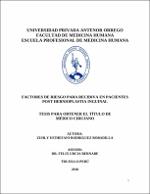| dc.contributor.advisor | Urcia Bernabe, Felix | |
| dc.contributor.author | Rodriguez Bobadilla, Zuhly Esthefani | |
| dc.creator | Rodriguez Bobadilla, Zuhly Esthefani | |
| dc.date.accessioned | 2018-05-02T22:00:51Z | |
| dc.date.available | 2018-05-02T22:00:51Z | |
| dc.date.issued | 2018 | |
| dc.identifier.uri | https://hdl.handle.net/20.500.12759/4085 | |
| dc.description.abstract | Objetivo: Nos preguntamos determinar los factores de riesgo para la recidiva en
pacientes post hernioplastía inguinal.
Material y Métodos: Se realizó un estudio comparativo, de casos y controles, de
corte retrospectivo. Se estudiaron 156 pacientes, 48 casos que presentaron recidiva
y 107 controles sin recidiva, que tuvieron hernioplastía inguinal en Clínica San
Gabriel Lima en el periodo 2017. Se realizó un análisis univariado, bivariado y
multivariado de los factores asociados.
Resultados: Las variables con nivel de significancia aceptado fueron antecedente
de hipertensión (OR 0.383 IC 95% 0.179-0.819; p=0.012), antecedente de
tabaquismo (OR 21.805 IC 95% 8.348-56,954 ; p=0.000), antecedente de
herniorrafía (OR 3.603 IC 95% 1,450-8,955; p=0.004), complicación
postquirúrgica dolor inguinal crónico (OR 2.335 IC 95% 1,166-4.674; p=0.016 .El
análisis multivariado indicó que tabaquismo obtuvo(p=0,001; OR 35.98 IC 95%
11,82 -109.57) antecedente de herniorrafía (p=0.001; OR 8,99 IC 95% 2.64 -
30.67) y edad (p=0,020; OR1,04 IC95% 1.01-1.08) con significancia para factores
de riesgo para recidiva de hernia inguinal postoperatoria.
Conclusiones: El tabaquismo y la herniorrafia son más probables de encontrar en
pacientes con recidiva de hernia inguinal postoperatoria, frente a aquellos pacientes
que no presentan estos factores de riesgo. | es_PE |
| dc.description.abstract | Objective: To determine the risk factors for recurrence in patients after inguinal
hernioplasty at Clínica San Gabriel.
Material and Methods: A comparative study of cases and controls, retrospective. 156
patients, 48 cases and 107 controls were enrolled, whose information was randomly
extracted from the clinical records of the institution. A univariate, bivariate and multivariate
analysis of the associated factors was performed.
Results: The variables with accepted level of significance were antecedents of
hypertension(OR 0.383 IC 95% 0.179-0.819; p=0.012), antecedent of smoking(OR 21.805
IC 95% 8.348-56,954 ; p=0.000) , antecedent of herniorrafia(OR 3.603 IC 95% 1,450-
8,955; p=0.004), , postsurgical complications (OR 2.335 IC 95% 1,166-4.674; p=0.016,
The multivariate analysis indicated that smoking obtained (p=0,001; OR 35.98 IC 95%
11,82 -109.57) and antecedent of herniorrafia (p=0.001; OR 8,99 IC 95% 2.64 -30.67).
Conclusions: Smoking and history of herniorrafia are more likely to be found in patients
with postoperative inguinal hernia recurrence, compared to patients who do not present
these risk factors. | en_US |
| dc.description.uri | Tesis | es_PE |
| dc.format | application/pdf | es_PE |
| dc.language.iso | spa | es_PE |
| dc.publisher | Universidad Privada Antenor Orrego | es_PE |
| dc.relation.ispartofseries | T_MED.HUMA_2391 | |
| dc.rights | info:eu-repo/semantics/openAccess | es_PE |
| dc.rights.uri | https://creativecommons.org/licenses/by/4.0/ | es_PE |
| dc.source | Universidad Privada Antenor Orrego | es_PE |
| dc.source | Repositorio Institucional - UPAO | es_PE |
| dc.subject | Herniplastía inguinal | es_PE |
| dc.subject | Recidiva | es_PE |
| dc.title | Factores de riesgo para recidiva en pacientes post hernioplastia inguinal | es_PE |
| dc.type | info:eu-repo/semantics/bachelorThesis | es_PE |
| thesis.degree.level | Título Profesional | es_PE |
| thesis.degree.grantor | Universidad Privada Antenor Orrego. Facultad de Medicina Humana | es_PE |
| thesis.degree.name | Médico Cirujano | es_PE |
| thesis.degree.discipline | Medicina Humana | es_PE |
| dc.subject.ocde | https://purl.org/pe-repo/ocde/ford#3.02.27 | es_PE |
| renati.type | https://purl.org/pe-repo/renati/type#tesis | es_PE |
| renati.level | https://purl.org/pe-repo/renati/level#tituloProfesional | es_PE |
| renati.discipline | 912016 | es_PE |
| dc.publisher.country | PE | es_PE |


